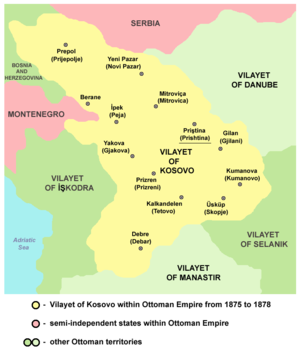- History of Ottoman Kosovo
-
History of Kosovo 
This article is part of a seriesEarly History Prehistoric Balkans Roman Empire Byzantine Empire Middle Ages Bulgarian Empire Medieval Serbia Battle of Kosovo Ottoman Kosovo Eyalet of Rumelia Vilayet of Kosovo Albanian nationalism 20th century First Balkan War Kingdom of Serbia Kingdom of Yugoslavia Albanian Kingdom AP Kosovo and Metohija SAP Kosovo AP Kosovo and Metohija Recent history Kosovo War UN administration 2008 Kosovo declaration of independence Contemporary Kosovo See also Timeline of Kosovo history
Kosovo Portal
Kosovo was part of the Ottoman Empire from 1455 to 1912, at first as part of the eyalet of Rumelia, and from 1864 as a separate Kosovo Vilayet.
During this period several administrative districts (known as sanjaks ("banners" or districts) each ruled by a sanjakbey (roughly equivalent to "district lord") have included parts of the territory as parts of their territories.
Contents
History
In 1689 Kosovo was greatly disrupted by the Great Turkish War (1683-1699), in one of the pivotal events in Serbian national mythology. In October 1689, a small Habsburg force under Margrave Ludwig of Baden breached the Ottoman Empire and reached as far as Kosovo, following their earlier capture of Belgrade. Many Serbs and Albanians pledged their loyalty to the Austrians, some joining Ludwig's army. This was by no means a universal reaction; many other Serbs and Albanians fought alongside the Ottomans to resist the Austrian advance. A massive Ottoman counter-attack the following summer drove the Austrians back to their fortress at Niš, then back to Belgrade, then finally back across the Danube into Austria.
The Ottoman offensive was accompanied by savage reprisals and looting, prompting many Serbs - including Arsenije III, Patriarch of the Serbian Orthodox Church - to flee along with the Austrians. This event has been immortalised in Serbian history as the Velika Seoba or "Great Migration". It is traditionally said to have accounted for a huge exodus of hundreds of thousands of Serbian refugees from Kosovo and Serbia proper, which left a vacuum filled by a flood of Albanian immigrants. Arsenije himself wrote of a figure of "30,000 souls" (i.e. individuals) who fled with him to Austria, a figure confirmed by other sources.
National awakening
Main article: National awakening of AlbaniaIn 1878, one of the four vilayets with Albanian inhabitants that formed the League of Prizren was Vilayet of Kosovo. The League's purpose was to resist both Ottoman rule and incursions by the newly-emerging Balkan nations.
In 1910, an Albanian-organised insurrection broke out in Pristina and soon spread to the entire vilayet of Kosovo, lasting for three months. The Ottoman sultan visited Kosovo in June 1911 during peace settlement talks covering all Albanian-inhabited areas.
Islamisation
Despite the imposition of Muslim rule, large numbers of Christians continued to live and sometimes even prosper under the Ottomans. A process of Islamisation began shortly after the beginning of Ottoman rule but it took a considerable amount of time - at least a century - and was concentrated at first on the towns. It appears that many Christian Albanian inhabitants converted directly to Islam, rather than being replaced by Muslims from outside Kosovo. A large part of the reason for the conversion was probably economic and social, as Muslims had considerably more rights and privileges than Christian subjects. Christian religious life nonetheless continued, with churches largely left alone by the Ottomans, but both the Serbian Orthodox and Roman Catholic churches and their congregations suffered from high levels of taxation.
Ethnic composition
Further information: Demographic history of Kosovo Ethnic composition map of the Balkans by the pro-Greek [1] A. Synvet of 1877, a French professor of the Ottoman Lyceum of Constantinople.
Ethnic composition map of the Balkans by the pro-Greek [1] A. Synvet of 1877, a French professor of the Ottoman Lyceum of Constantinople.
Around the 17th century, there is evidence of an increasingly visible Albanian population initially concentrated in Metohia. It has been claimed this was the result of migrations out of the south-west (i.e. modern Albania), and that the putative migrants brought Islam with them. There is certainly evidence of migration: many Kosovo Albanians have surnames characteristic of inhabitants of the northern Albanian region of Malësi. However, many others do not. It is also clear a small number of Slavs - presumably members of the Serbian Orthodox Church - converted to Islam under Ottoman rule. Today, most Slavic Muslims of Serbia live in the Sandžak region of southern Serbia, northwest of Kosovo. Some historians believe that there was probably a pre-existing population of probably Catholic Albanians in Metohia who mostly converted to Islam, but remained strictly a minority in a still largely Serb-inhabited region.
See also
- Rumelia
- Kosovo Vilayet
References
- ^ Robert Shannan Peckham, Map mania: nationalism and the politics of place in Greece, 1870–1922, Political Geography, 2000, p.4: [1] "Other maps by amongst others the Frenchman F. Bianconi [1877], who was the chief architect and engineer of the Ottoman railways, A. Synvet [1877] and Karl Sax [1878], a former Austrian consul in Andrianople, were similarly favourable to the Greek cause."
History of modern states under the Ottoman Empire Africa Asia Europe Albania · Bosnia and Herzegovina · Bulgaria · Greece · Hungary · Kosovo · Macedonia · Montenegro · SerbiaCategories:- Ottoman Kosovo
Wikimedia Foundation. 2010.




